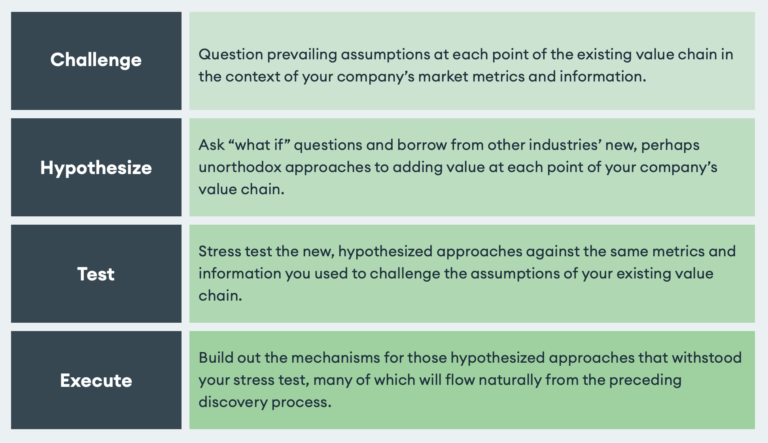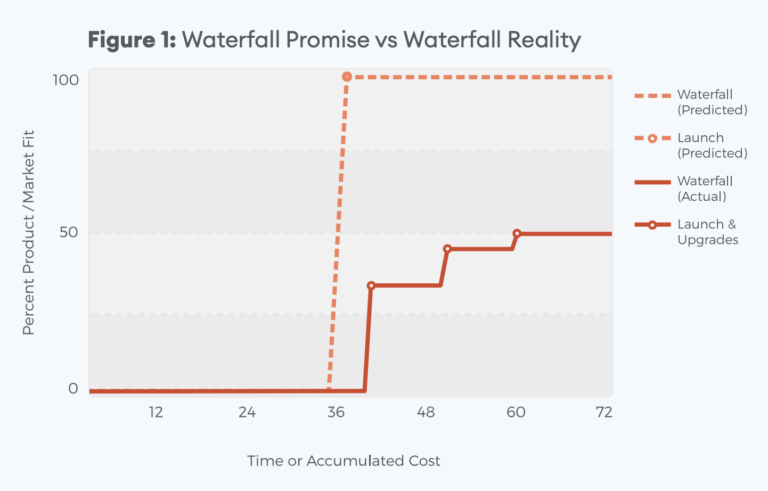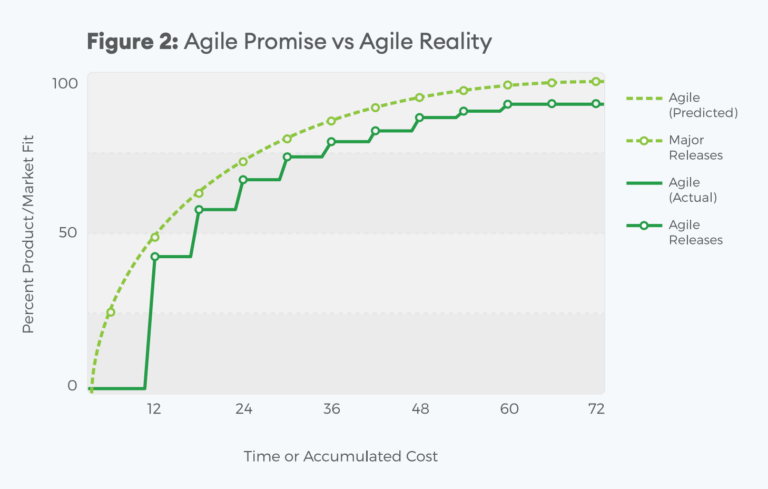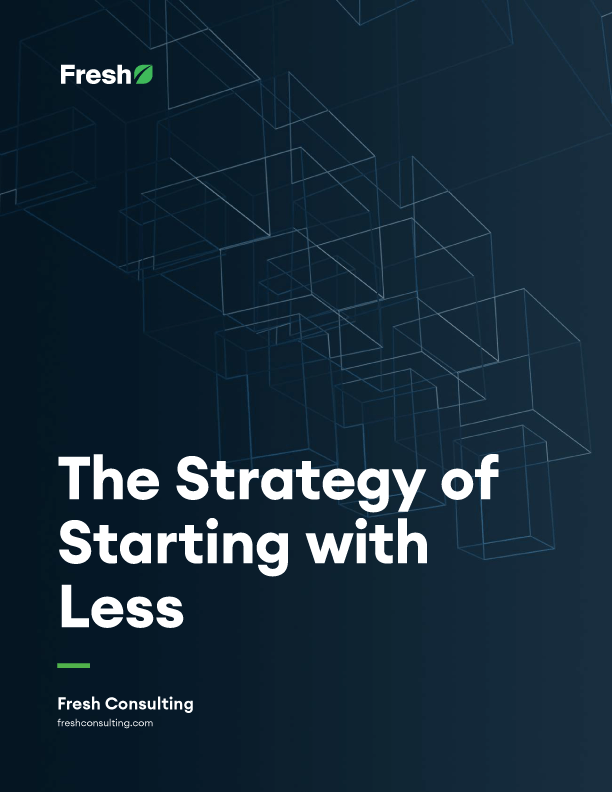Article
Seven Key Principles for Strategic Innovation

There’s risk in not innovating. When faced with the destructive potential of technological change – including competitors, new entrants, globalization, substitute products, generational shifts, and more – established companies must continue to innovate in order to maintain their competitive advantage.
To stay ahead of the curve, today’s executive leaders should ideally focus on building their company’s long-term competitive advantage, thus ensuring their future in the marketplace. We recommend seven key principles as a starting point.
1. Create a Culture of Core-Driven Innovation
Start at the Top
Leadership who view innovation primarily as a risk associated with shifting valuable resources to product and services initiatives miss the bigger picture. By focusing on innovation that merely bridges the incremental innovation gap, their companies eventually lose enough strategic ground that no amount of innovation is going to keep them alive. When those same executives acknowledge that not innovating poses a far greater risk to their core business and competitive advantage, however, they will more readily allocate the resources and effort to power that advantage.
In fact, according to the Harvard Business Review, leaders who champion innovation as a cultural norm are not only as focused on managing risk as innovation-avoidant leaders, they are 25% more focused on it. The difference is that these leaders shift their focus from the risk of innovating to the risk of market share loss and decreased revenue resulting from a lack of core-driven innovation.
Make Innovation Everyone’s Business
According to Michael Porter, successful business strategy is, in one sense, nothing more than creating “fit” among the various functions of a company and looking beyond mere operational effectiveness. If the goal is to innovate strategically instead of just incrementally, then innovation must take place at all levels and through all functions of a company’s value chain.
Several examples of strategic innovation at different places along the value chain include Apple and Toyota. Arguably, the company-wide innovation approaches Apple has taken—from product packaging to customer experience to partner agreements— contributed more to its strategic success than making incremental feature improvements to products like its iPhones and iPads.
Growing from nearly bankrupt in the 1950s to becoming the largest automaker in the world today, Toyota arguably owes the bulk of that growth to the well-documented innovations it has continually made to its manufacturing processes. Although in-store experiences and manufacturing processes aren’t the areas we typically attribute to cutting-edge innovation, when strategically implemented over the long term, they make all the difference.

2. Innovate Business Models and Processes, Not Just Products and Services
A survey conducted by McKinsey & Company showed that 80% of chief strategy officers across a wide range of industries believed that their existing business models were at risk. And among the biggest concerns those strategy officers face are small entrants into their markets who are leveraging disruptive technology and process innovations.
While many strategy executives will focus on product innovation as a way to compete with the disruption, that strategy may be short-sighted as it misses the opportunity for established companies to leverage their existing knowledge and experience.
Value Chain Innovation
It’s admittedly easier to focus on new products and services when discussing innovation—but without a sound strategy for leveraging customer, market, and industry knowledge, and detecting and reacting to changes in the perceptions, biases, and efficacies underlying a company’s value chain—large companies run a significant risk of becoming strategically irrelevant.
One notable example of a company that has focused on more than just its products by managing long-term risk with a more strategic, core-driven approach is Nike. Well known for continuously innovating their products, brand messaging, and customer experience, Nike has successfully leveraged supply chain innovation as a means to cutting lead times, controlling logistical costs, and mitigating environmental impact issues.
Although these innovations may initially seem only supply-side related, because Nike knows its customers so well, these changes have intentionally added extra value to its value chain. As a result, Nike has maintained its long-term competitive advantage in the athletic footwear and apparel industry.
Recognizing that business model innovation is the surest approach to managing long-term strategic risk, the following roadmap represents a proven process for ensuring that a company’s value chain stays aligned with its customers’ evolving needs and preferences.

3. Use Agile Innovation Management to Involve the Customer for Superior Product and Market Fit
Another strategic approach to managing risk involves the way organizations manage innovation itself.
Although native to a project management methodology for software products, using a more “Agile-ish” approach to managing innovation can alleviate significant risk across a broad range of initiatives. In fact, 95% of Scrum (a form of Agile project management) users plan to continue using an Agile approach on both large and small projects due to the myriad of benefits associated with the model. Of the more significant of those benefits is the reduction in project risk that 76% of Scrum participants reported.
To understand why Agile innovation reduces project risk while at the same time yields better results, let’s quickly compare the Agile development model with the highly outdated Waterfall development model.
The Waterfall Methodology
Waterfall is a plan-driven development method modeled after the construction management process. Although software developers have long criticized this methodology as being synonymous with poorly designed, bug-ridden software, many executives and senior management still favor this form of development due to what we at Fresh refer to as the “Waterfall promise” — that the process will yield a product that is a perfect fit for market, on time, and on budget.

But as Figure 1 shows, the Waterfall promise is far from the Waterfall reality. In short, the budget/resource certainty executives crave with Waterfall is seldom actually achieved. When it is, it’s usually only for projects that have been well documented and predictable.
The Agile Methodology
Unlike Waterfall’s illusive certainty and predictability, the Agile process is built on iteration, where product/market fit is an inevitability because setbacks and unforeseen detours are built into the development process.

Where Waterfall often misses the market due to changes between project launch and completion, Agile seeks to time its products to the market or — as Steve Jobs did so masterfully — even time them ahead of it.
4. Develop and Leverage Strong Innovation Partners to Bring in Fresh Perspectives and Diffuse Risk
Historically, large corporate R&D departments, universities, and grant-funded start-ups have been the organizations with the resources to innovate new technologies, but as technology itself has lowered capital and access barriers to innovation, great ideas and products can come from anywhere. In fact, these days, a college student with a laptop could be the creator of the next billion dollar disruption.
For executives of organizationally defined companies, this sea change in the innovation environment has incentivized them to look outside their own organizations and even industries for an innovative edge. Developing and leveraging strong outside innovation partners has several risk management benefits.
Overcoming Organizational Gridlock = Greater Speed to Market
One of the primary risks associated with innovating is not being able to do it quickly enough. Today, the companies that learn the fastest win, and once the executives and senior management of a company identify a quantifiable innovation need (stage four in business model innovation, discussed earlier), the next step is to identify and marshal the resources necessary to develop the solution and bring it to market as quickly as possible. This can prove to be very difficult even for companies with the resources to staff and fund sizable internal innovation departments and initiatives. Although those companies may be well-heeled enough, their organizational structures often hinder their ability to coordinate cooperation among relevant departments and stakeholders.
Having strong innovation partners and networks allows organizationally complex companies to leverage outside talent and efficiencies. These partnerships can significantly alleviate the gridlock that occurs when companies rely on their own internal resources to bring innovation to market.
Tapping Outside Knowledge for Fresh Approaches
Successful companies know what makes them successful, but that self-awareness can breed a form of “innovation tunnel vision” where leaders rely only on the knowledge within their organization and sector when it comes to solving problems and thinking innovatively.
Unfortunately, this inward-looking approach ignores the fact that some of the biggest success stories in the innovation space have resulted from leaders leveraging and translating technology and innovation gains in other industries for the benefit of their own.
A prime example of this is how innovations derived from desktop publishing technology are changing the design and product manufacturing industry. Specifically, the same technology that has allowed the owner of any personal computer to create, print, and publish their own literary works is now giving rise to a wave of similarly-situated entrepreneurs who are able to design, print, and sell their own three-dimensional products.
Although it may seem obvious now, the innovative leap from using an inkjet printer to deposit small drops of ink onto a paper to create a document to using a not-too-different printer head to heat and deposit solid material three-dimensionally has potentially revolutionized the small-batch manufacturing business. 3D printing technology is now crossing over into even more, seemingly unrelated industries, such as bioprinting, where 3D printing-based technology is being developed to create human organs.
It may be less obvious than other principles of innovation, but by having strong innovation partners and networks in place outside of its native industry, a company can leverage the know-how, talent, and insight from other industries to innovate successful technology and process applications within its own.
Decentralizing Risk
In a partnership/contractual setting, risk is allocated under two predominant theories. First, risk is allocated among participating parties proportional to the benefit each respective party receives from the joint endeavor. And second, risk is allocated among parties according to who is in the best position to manage and/or mitigate that risk.
Leveraging innovation partners who bring necessary competencies and experience to the table—tied with a stake in the outcome of the innovative process—provides an efficient and logical avenue for reducing risk that would otherwise be inherently concentrated on your organization.

5. Include Risk Management in the Innovation Process from the Start to Manage Speed to Market
Supply chain, sourcing, risk management, operations—in large organizations, these are the business functions that have historically stood in the way of innovation. It makes sense: change is risky if for no other reason than it represents a product or process different from what’s known and quantifiable.
Risk-averse functions serve a critical role in their organizations, but the better they do their job, the more they can shut down the key ingredients that feed innovation. No qualified leader would disagree that a company’s risk function should slow things down when issues emerge in the innovation process.
The problem arises, however, when the process of coming up with risk-acceptable solutions absorbs more focus than the process of developing the innovative products or processes in the first place. The solution to this problem involves rethinking the role a company’s risk functions play in the innovation process. One way to mix things up is to make the risk management functions also accountable to innovation initiatives so they have balanced objectives.
According to a survey conducted by Accenture that gathered data on the role a company’s risk management functions play in its innovation culture and processes, risk executives whose companies successfully manage innovation risk are twice as likely as “non-adapters” to advise on innovation initiatives and activities even before the planning begins.
Although not a groundbreaking concept, plugging the risk function into the innovation pipeline as far upstream as possible allows risk managers to anticipate problems and strategize potential pivots and solutions in advance. In turn, this allows the innovative process to move forward as quickly and effectively as possible. In an age where speed to market and strategic agility are critical factors to long-term success, that efficiency is vital.
Furthermore, not only does leveraging the risk management function early in the innovation process equip companies to innovate more quickly and tightly, but this Agile-style approach allows innovation teams to deal with issues that were not or could not be anticipated at the entrance to the pipeline.
6. Establish Innovation Principles
Innovation is not a natural fit for established companies that have honed themselves over time to satisfy their core customers’ existing needs and wants. Trying to implement innovation initiatives without putting in place an actual pipeline for those initiatives from the ideation stage to the launch stage will likely be fruitless.
Innovation pipelines, like other internal project management functions, work because they provide a process and associated metrics to which mid-level leadership can manage. As ideas make their way through the pipeline, they can be systematically vetted not only for technical feasibility, but also for business feasibility.
While we won’t get into the details of the pipeline here, typical innovation pipelines usually consist of at least the following five stages.
Ideation
There is no faster way to kill innovation within a company than to put responsibility for it in the hands of only a small few. A company’s employees, from line workers all the way up to C-Suite are ALL sources of invaluable insight into what is and is not working, and what can be improved.
Feasibility
Feasibility is the stage-gate where those innovative ideas are assessed as viable or not both from a technical perspective and measured against a company’s strategic objectives. For technology-centric innovation, there is no sense scrutinizing ideas from a business perspective if the innovation isn’t technically feasible.
Development
For those ideas that are not only technically feasible, but also provide a compelling business case, companies must be prepared to allocate the time, capital, and other resources to further refine and develop innovative ideas into working processes and products.
Launch
Recognizing that the scale of the launch is going to be governed by many different factors and conditions, it will nearly always be better to attach metrics and limit it to no broader of a scope than is necessary for validating or disproving the assumptions made during both the feasibility and development stages.
Validate & Scale
The final step is to measure the result of a company’s launch against the assumptions it made earlier in the process. From there, the company can take several different routes. If positive, the results may warrant an expanded offering or implementation into a larger scope of the market or across a larger percentage of a particular internal division.
If the results are neutral or negative, the decision could be made to abandon the initiative or, alternatively, to send it back to the development stage of the pipeline for improvements that will bring the initiative more in line with the company’s expectations.

7. Utilize Innovation Entities
If the functional, organizational, and structural ways in which a large, successful company meets its customers’ needs are what ultimately become the barrier to the company engaging in strategic-level innovation, then an obvious workaround to this problem is to create a distinct entity whose sole purpose focusing on the innovation initiative(s) that are seemingly too incompatible for the existing enterprise to stomach.
An organization decoupled from the parent company, a “lab,” as we like to call it, has the freedom to establish its own operational, cultural, and performance metrics, instead of being forced (intentionally or not) to fit into the parent company’s long-established way of doing business.
Of course, the fruits of the lab’s efforts ultimately have to funnel into the parent, and so the innovation lab has to have a product development and innovation pitch pipeline that ties the hard work the innovation product teams perform in developing and validating their innovative ideas into the core business’ strategic leadership to ensure the ideas coming out of the lab don’t end up being orphans.
Since these ideas are strategic expenditures, a close connection between the lab and executive leadership also ensures that innovations worth pursuing receive the “investment” required to further develop and incorporate them into the core company’s value chain.

Conclusion
To withstand the challenges that will inevitably come from new entrants, new technology, the bargaining power of suppliers and buyers, and the threat of substitute products or services, enterprise leaders need to dig deeper and innovate at a more strategic, more “core” level.










